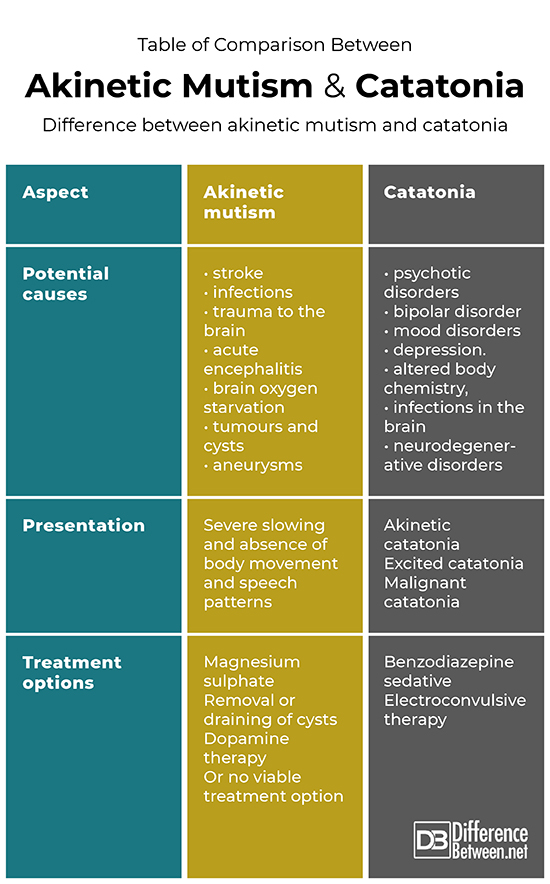Difference Between Akinetic Mutism and Catatonia

Introduction
Catatonia and akinetic mutism are both conditions associated with a person’s mental state and mental function. Where catatonia presents with similar symptoms as akinetic mutism, the condition is not a result of traumatic events (as seen in akinetic mutism), but rather most common in patients diagnosed with mental illnesses. The two conditions overlap in many aspects, however, the mechanisms behind the causes and the treatment plans differ greatly. This provides a clearer understanding of what truly distinguishes catatonia and akinetic mutism from each other.

Difference between Akinetic Mutism and Catatonia
Definition and Pathophysiology
Catatonia is the group definition for symptoms including lack of movement and communication, accompanied by restlessness, agitation, and/or states of confusion and delirium. This condition was previously classified as a type of schizophrenia; however, specialist physicians of today’s time have come to understand that other medical conditions and mental illnesses can alter the metabolic systems in the body, resulting in a catatonic state.
There are three main types of catatonias, including:
- Akinetic catatonia: the most commonly occurring type. Patients suffering from akinetic catatonia are often unresponsive, stare blankly when spoken to, and often won’t move out of unusual sitting or laying positions.
- Excited catatonia: a type where patients move around impulsively and pointlessly. Those diagnosed with excited catatonia are often agitated, delirious, and replicate movements when somebody is trying to assist them.
- Malignant catatonia: the dangerous type. Malignant catatonia causes symptoms which lead to additional health issues such as a dangerous change in heart rate, blood pressure, rate of breathing, and intense changes in body temperature. When this state of catatonia occurs for a long time, problems such as blood clots and kidney failure could result.
Akinetic mutism involves the severe slowing and absence of body movement and speech patterns. It is a rare condition that has been reported in patients (often children) suffering brain tumours, central nervous system infections (both bacterial or viral infections), a condition where there is accumulation of fluid in the brain termed hydrocephalus, and on the rare occasion as a post-operative complication. Akinetic mutism results in a severely reduced mental function but a present wakefulness and preserved self-awareness.
Potential causes
Medical specialists and physicians still aren’t quite sure what the cause behind catatonia is. What has been noted, is that the three types of catatonias present most often in patients who are suffering mental illnesses including psychotic disorders, bipolar disorder (makes up almost a third of these patients), mood disorders, and depression. There are a few physical disorders that may result in catatonia without accompanying mental illness. These include conditions altering body chemistry, infections in the brain (such as encephalitis), and neurodegenerative disorders (such as Parkinson’s disease)
Akinetic mutism can be the result of a stroke occurring in the thalamus of the brain, infections such as meningitis, trauma to the brain, acute encephalitis, a resultant condition of oxygen starvation to the brain, the occurrence of tumours and cysts, aneurysms, and central nervous systems infections.
Symptoms
Doctors will most likely diagnose a patient as catatonic if they present with any three of the following symptoms:
- Unresponsive to people or the surrounding environment
- Mimicking somebody’s movements or speech
- Agitated or resist body adjustment
- Keeping the body in an unusual position
- Not speaking
- Repetitive, pointless body movements
The symptoms of akinetic mutism, on the other hand, are as follows:
- Reduced and/or absence motor functions (not complete paralysis)
- Reduced and/or absence of speech capabilities
- Reduction or absence of inhibition and emotions
- Apathetic movement and ever-present slowness
Diagnosis
Catatonia is diagnosed when patients present with any three of the above listed symptoms. Abnormal vital signs (such as tachycardia and high blood pressure), coupled with poor oral intake of food and fluids, are additional diagnostic signs that a patient is catatonic.
Akinetic mutism can be misdiagnosed as a mental health illness such as depression. This is because the cases often present similarly, but correct diagnosis is important for adequate and effective treatment. In addition to brain scans and blood tests, akinetic mutism is diagnosed when patients present with a reduced or severely impaired (sometimes loss) state in most motor and speech functions and may sometimes present with a level alertness and response.
Treatment
Catatonia is usually treated with a benzodiazepine sedative, also used to treat anxiety. In severe cases where sedative treatment doesn’t work or immediate life-saving action is needed, electroconvulsive therapy is an option. Electroconvulsive therapy is a treatment that sends electrical impulses into the brain through electrodes that have been positioned on along the head.
Akinetic mutism is treated according to the severity and cause, and may include:
- Magnesium sulphate
- Removal or draining of cysts causing the condition
- Dopamine therapy
In other cases, there is no viable treatment option for the patient.
Table of comparison between akinetic mutism and catatonia

Summary of Akinetic Mutism and Catatonia
Akinetic mutism presents as severe slowing of body movements and speech patterns and is usually a result of a traumatic event to the brain. Catatonia can present as an akinetic state, an excited state, or a state of mind which results in severe health issues. Catatonia is usually caused by disorders associated with mental illnesses, but an absolute cause is not yet fully understood.
FAQ
What is Akinetic catatonia?
Akinetic catatonia is the most commonly occurring type of catatonic state. Patients are mostly unresponsive, stare blankly when spoken to, and often won’t move out of unusual body positions.
Is akinetic mutism coma?
Akinetic mutism is not a coma but can easily be mistaken for one. Patients with akinetic mutism are fully awake and responsive with the ability to communicate but not through a suitable verbal response (sometimes present but significantly delayed) and usually void of emotions. Paralysis or coma are not accounted for symptoms of akinetic mutism.
How long does akinetic mutism last?
Akinetic mutism can occur over a short-term (a few months) when the cause can be rapidly reversed or treated, or it may be life-long if the cause resulted in permanent damage to the brain.
How do you describe catatonia?
Catatonia or catatonic state happens when symptoms including lack of movement and communication, restlessness, agitation, and/or states of confusion and delirium occur together.
- Difference Between a Cochlear Implant and Normal Hearing - October 4, 2022
- Difference Between Obstructive and Restrictive Spirometry - September 11, 2022
- The Difference Between White Box and Black Box Testing - September 11, 2022
Search DifferenceBetween.net :
Leave a Response
References :
[0]Ellul, Paul and Choucha, Walid. Neurobiological Approach of Catatonia and Treatment Perspectives. Frontiers in Psychiatry. 2015, vol. 6: 182.
[1]Shetty, Anita., Morris, John and O’Mahony, Paul. Akinetic mutism—not coma. Age Aging. 2009, vol. 38, no. 3, pp: 350-1.
[2]Walther, Sebastian and Strik, Werner. Catatonia. CNS Spectrums. 2016, vol. 21, pp: 341-348.
